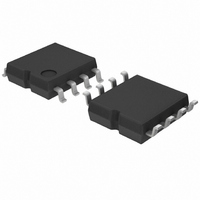BU7262SF-E2 Rohm Semiconductor, BU7262SF-E2 Datasheet - Page 13

BU7262SF-E2
Manufacturer Part Number
BU7262SF-E2
Description
OP AMP I/O LV 1.8-5.5V 8-SOP
Manufacturer
Rohm Semiconductor
Specifications of BU7262SF-E2
Slew Rate
1.1 V/µs
Amplifier Type
General Purpose
Number Of Circuits
2
Output Type
Rail-to-Rail
Gain Bandwidth Product
2MHz
Current - Input Bias
1pA
Voltage - Input Offset
1000µV
Current - Supply
550µA
Current - Output / Channel
12mA
Voltage - Supply, Single/dual (±)
1.8 V ~ 5.5 V, ±0.9 V ~ 2.75 V
Operating Temperature
-40°C ~ 105°C
Mounting Type
Surface Mount
Package / Case
8-SOP
Op Amp Type
CMOS
No. Of Amplifiers
2
Bandwidth
2MHz
Supply Voltage Range
± 0.9V To ± 2.75V
Amplifier Case Style
SOIC
No. Of Pins
8
Operating Temperature Range
-40°C To
Number Of Channels
2
Common Mode Rejection Ratio (min)
45 dB
Input Offset Voltage
9 mV
Input Bias Current (max)
1 pA
Operating Supply Voltage
3 V, 5 V
Supply Current
1.1 mA
Maximum Operating Temperature
+ 105 C
Minimum Operating Temperature
- 40 C
Maximum Dual Supply Voltage
+/- 2.75 V
Minimum Dual Supply Voltage
+/- 0.9 V
Mounting Style
SMD/SMT
Shutdown
No
Supply Voltage (max)
5.5 V
Supply Voltage (min)
1.8 V
Technology
CMOS
Voltage Gain Db
95 dB
Lead Free Status / RoHS Status
Lead free / RoHS Compliant
-3db Bandwidth
-
Lead Free Status / Rohs Status
Lead free / RoHS Compliant
Other names
BU7262SF-E2TR
Available stocks
Company
Part Number
Manufacturer
Quantity
Price
Company:
Part Number:
BU7262SF-E2
Manufacturer:
Rohm
Quantity:
5 995
● Description of electrical characteristics
1. Absolute maximum ratings
2.
1.1
1.2
1.3
1.4
2.1
2.2
2.3
2.4
2.5
2.6
2.7
2.8 Common-mode rejection ratio (CMRR)
2.9 Power supply rejection ratio (PSRR)
2.10 Channel separation(CS)
2.11 Slew rate (SR)
2.12 Unity gain frequency (ft)
2.13 Total harmonic distortion + Noise (THD+N)
2.14 Input referred noise voltage (Vn)
Absolute maximum rating item indicates the condition which must not be exceeded. Application of voltage in excess of absolute
Maximum rating or use out of absolute maximum rated temperature environment may cause deterioration of dharacteristics.
Electrical characteristics item
Described here are the terms of electric characteristics used in this technical note. Items and symbols used are also shown.
Note that item name and symbol and their meaning may differ from those on another manufacture’s document or general document.
Indicates the maximum voltage that can be applied to non-inverting terminal and inverting terminal without deterioration or destruction of
characteristics. Input common-mode voltage range of the maximum ratings not assure normal operation of IC. When normal
Indicates the fluctuation of input offset voltage or that of output voltage with reference to the change of output voltage
of driven channel
Indicates a noise voltage generated inside the operational amplifier equivalent by ideal voltage source connected
in series with input terminal
Indicates a frequency where the voltage gain of Op-Amp is 1.
Indicates the maximum voltage that can be applied between the positive power supply terminal and negative power supply terminal
without deterioration or destruction of characteristics of internal circuit.
Indicates the maximum voltage that can be applied between non-inverting terminal and inverting terminal without deterioration and
destruction of characteristics of IC.
Operation of IC is desired, the input common-mode voltage of characteristics item must be followed.
Indicates the power that can be consumed by specified mounted board at the ambient temperature 25℃(normal temperature). As for
package product, Pd is determined by the temperature that can be permitted by IC chip in the package(maximum junction temperature)
and thermal resistance of the package
Indicates the voltage difference between non-inverting terminal and inverting terminal. It can be translated into the input voltage
difference required for setting the output voltage at 0 [V]
Indicates the difference of input bias current between non-inverting terminal and inverting terminal.
Indicates the current that flows into or out of the input terminal. It is defined by the average of input bias current at non-inverting terminal
and input bias current at inverting terminal.
Indicates the IC current that flows under specified conditions and no-load steady status.
Indicates the voltage range that can be output by the IC under specified load condition. It is typically divided into high-level output voltage
and low-level output voltage. High-level output voltage indicates the upper limit of output voltage. Low-level output voltage indicates the
lower limit.
Indicates the amplifying rate (gain) of output voltage against the voltage difference between non-inverting terminal and inverting terminal.
It is normally the amplifying rate (gain) with reference to DC voltage.
Av = (Output voltage fluctuation) / (Input offset fluctuation)
Indicates the input voltage range where IC operates normally.
Indicates the ratio of fluctuation of input offset voltage when in-phase input voltage is changed. It is normally the fluctuation of DC.
CMRR =(Change of Input common-mode voltage)/(Input offset fluctuation)
Indicates the ratio of fluctuation of input offset voltage when supply voltage is changed. It is normally the fluctuation of DC.
PSRR=(Change of power supply voltage)/(Input offset fluctuation)
Indicates the fluctuation of input offset voltage or that of output voltage with reference to the change of output voltage of driven channel.
Indicates the time fluctuation ratio of voltage output when step input signal is applied
Power supply voltage
Differential input voltage (Vid)
Input common-mode voltage range (Vicm)
Power dissipation (Pd)
Input offset voltage (Vio)
Input offset current (Iio)
Input bias current (Ib)
Circuit current (ICC)
High level output voltage / Low level output voltage(VOH/VOL)
Large signal voltage gain (AV)
Input common-mode voltage range (Vicm)
(VDD/VSS)
13/16









